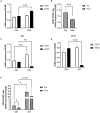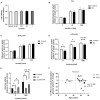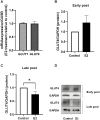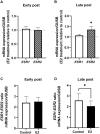Role of Estrogen and Its Receptors in Adipose Tissue Glucose Metabolism in Pre- and Postmenopausal Women
- PMID: 35084504
- PMCID: PMC9016422
- DOI: 10.1210/clinem/dgac042
Role of Estrogen and Its Receptors in Adipose Tissue Glucose Metabolism in Pre- and Postmenopausal Women
Abstract
Context: Reduced estrogen levels in postmenopausal women predispose them to metabolic side effects, including insulin resistance and type 2 diabetes; however, the cellular mechanisms are not well understood.
Objective: This work aimed to study the expression of estrogen receptors in adipose tissue from pre- and postmenopausal women and the effects of estradiol (E2) on glucose uptake of adipocytes.
Methods: Subcutaneous (SAT) and visceral adipose tissue (VAT) obtained from pre- and postmenopausal women (19-51 and 46-75 years old, respectively) were used to measure gene expression of ESR1 and ESR2. SAT tissue was incubated with E2, and glucose uptake and estrogen receptor levels were measured. Polymorphisms in ESR1 and ESR2 were addressed in public databases to identify single nucleotide polymorphisms associated with metabolic traits.
Results: ESR2 expression was lower in pre- vs postmenopausal women, corresponding to lower ESR1:ESR2 gene expression ratio in postmenopausal women. In premenopausal women, the expression of ESR1 was higher in VAT than in SAT. In both pre- and postmenopausal women, ESR2 expression was lower in VAT than in SAT. In late, but not pre- or early postmenopausal women, E2 reduced glucose uptake and GLUT4 protein and increased expression of ESR2. ESR1 polymorphisms were associated with weight, body fat distribution, and total cholesterol, and ESR2 polymorphisms were associated with total cholesterol and triglyceride levels and with body fat percentage.
Conclusion: E2 inhibits glucose utilization in human adipocytes in late postmenopausal women. Changes in glucose utilization over time since menopause may be explained by a lower ESR1:ESR2 ratio. This can have clinical implications on the timing of estrogen treatment in postmenopausal women.
Keywords: adipose tissue; estradiol; insulin resistance; menopause; type 2 diabetes.
© The Author(s) 2022. Published by Oxford University Press on behalf of the Endocrine Society.
Figures




Similar articles
-
Age- and menopause-related differences in subcutaneous adipose tissue estrogen receptor mRNA expression.Steroids. 2017 May;121:17-21. doi: 10.1016/j.steroids.2017.03.001. Epub 2017 Mar 10. Steroids. 2017. PMID: 28288896 Free PMC article.
-
Estradiol-mediated improvements in adipose tissue insulin sensitivity are related to the balance of adipose tissue estrogen receptor α and β in postmenopausal women.PLoS One. 2017 May 4;12(5):e0176446. doi: 10.1371/journal.pone.0176446. eCollection 2017. PLoS One. 2017. PMID: 28472101 Free PMC article. Clinical Trial.
-
Altered expression of aromatase and estrogen receptors in adipose tissue from men with obesity or type 2 diabetes.J Clin Endocrinol Metab. 2025 Jan 21:dgaf038. doi: 10.1210/clinem/dgaf038. Online ahead of print. J Clin Endocrinol Metab. 2025. PMID: 39833659
-
Estrogen and Glycemic Homeostasis: The Fundamental Role of Nuclear Estrogen Receptors ESR1/ESR2 in Glucose Transporter GLUT4 Regulation.Cells. 2021 Jan 7;10(1):99. doi: 10.3390/cells10010099. Cells. 2021. PMID: 33430527 Free PMC article. Review.
-
Association of polymorphisms in estrogen receptors (ESR1 and ESR2) with male infertility: a meta-analysis and systematic review.J Assist Reprod Genet. 2014 May;31(5):601-11. doi: 10.1007/s10815-014-0212-5. Epub 2014 Mar 20. J Assist Reprod Genet. 2014. PMID: 24647635 Free PMC article.
Cited by
-
Effect of Arthrospira maxima Phycobiliproteins, Rosiglitazone, and 17β-Estradiol on Lipogenic and Inflammatory Gene Expression during 3T3-L1 Preadipocyte Cell Differentiation.Int J Mol Sci. 2024 Jul 10;25(14):7566. doi: 10.3390/ijms25147566. Int J Mol Sci. 2024. PMID: 39062809 Free PMC article.
-
Phyllanthi Fructus ameliorates hyperuricemia and kidney injure via inhibiting uric acid synthesis, modulating urate transporters, and alleviating inflammation.Sci Rep. 2024 Nov 11;14(1):27605. doi: 10.1038/s41598-024-79350-x. Sci Rep. 2024. PMID: 39528682 Free PMC article.
-
Hepatic Estrogen Receptor Alpha Overexpression Protects Against Hepatic Insulin Resistance and MASLD.Pathophysiology. 2025 Jan 3;32(1):1. doi: 10.3390/pathophysiology32010001. Pathophysiology. 2025. PMID: 39846638 Free PMC article.
-
The association of lipid metabolism with bone metabolism and the role of human traits: a Mendelian randomization study.Front Endocrinol (Lausanne). 2023 Dec 6;14:1271942. doi: 10.3389/fendo.2023.1271942. eCollection 2023. Front Endocrinol (Lausanne). 2023. PMID: 38125793 Free PMC article.
-
Menopausal status-dependent alterations in the transcript levels of genes encoding ERα, ERβ, PR and HER2 in breast tumors with different receptor status.Clin Transl Oncol. 2025 Jun;27(6):2441-2452. doi: 10.1007/s12094-024-03777-x. Epub 2024 Nov 4. Clin Transl Oncol. 2025. PMID: 39495410
References
-
- Mattsson C, Olsson T. Estrogens and glucocorticoid hormones in adipose tissue metabolism. Curr Med Chem. 2007;14(27):2918-2924. - PubMed
-
- Louet JF, LeMay C, Mauvais-Jarvis F. Antidiabetic actions of estrogen: insight from human and genetic mouse models. Curr Atheroscler Rep. 2004;6(3):180-185. - PubMed
Publication types
MeSH terms
Substances
Grants and funding
LinkOut - more resources
Full Text Sources
Medical
Research Materials
Miscellaneous

